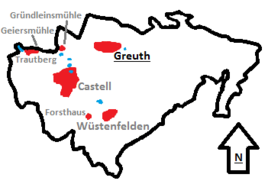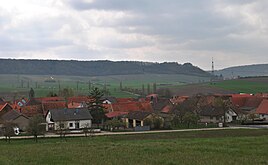Greuth (Castell)
|
Greuth
Municipality of Castell
Coordinates: 49 ° 45 ′ 6 ″ N , 10 ° 22 ′ 5 ″ E
|
|
|---|---|
| Height : | 288 m |
| Residents : | 200 |
| Incorporation : | July 1, 1977 |
| Postal code : | 97355 |
| Area code : | 09383 |
|
Location of Greuth in the Casteller municipality
|
|
Greuth is a district of the municipality of Castell in the Lower Franconian district of Kitzingen .
Geographical location
Greuth is located in the northeast of the municipality of Castell. The neighboring communities (clockwise) are Abtswind in the north, the Geiselwinder district of Rehweiler in the northeast, Dürrnbuch in the east, the Neustadt an der Aisch-Bad Windsheim district in the southeast, and Wüstenfelden in the south, another Casteller district. In the south-west and west is Castell, in the north-west is Rüdenhausen . In the district of Greuth is the 457 m high Greuther Berg , an elevation of the Steigerwald . Wine is grown on its slopes.
The closest, larger cities are Kitzingen, about 15 kilometers away, and Würzburg , more than 30 kilometers away.
history
Greuth was first mentioned in 1265 under the name "Geruthe". The name, later also changed to “Geruit sita sub castris Kastele” (Greuth, located below Castell Castle ), identifies the village as a clearing settlement . The street village still has its original layout today. In the Middle Ages, there were a total of twelve courtyards, the land of which ran as a strip to the border of the marker.
The village was one of the places that belonged to the Castell counts as early as the 11th century . In the year it was first mentioned, however, the counts gave the village to the Würzburg monastery , which in turn gave it back to the Casteller. Greuth later returned to the Countesses of Castell as a Wittumsgut . In 1408 the village consisted of 19 farms. Between 1702 and 1712 Greuth received a schoolhouse for the first time.
In the 19th century, the Greuther people increasingly built so-called Austragshäuses opposite the old houses, so that the image of the village changed. The Second World War largely spared the remote Steigerwalddorf. In September 1941 an airplane crossed the district of the place. It dropped several bombs on the meadows and fields in the area. A single barn burned down. In 1977 Greuth became part of the municipality of Castell.
The four public wells that supplied the village with water from the so-called Wolfberg had already served their purpose in 1958 when the village was connected to the Franconian long-distance water supply . In the course of incorporation into Castell, the municipality reserved the right to designate a new building area. This settlement "Im Kampf" is in the east of the old village. The previously used consecutive house numbers were replaced by street names in 1980.
Culture and sights
Architectural monuments
At the beginning of the 19th century, the village school with a roof turret was built in Greuth . Today the building is used as the parish hall of the Evangelical Church. In the prayer room in the left part of the house there is a simple, neoclassical pulpit altar .
Due to its history as a clearing village, simple farmhouses from the 18th and 19th centuries dominate the townscape.
Say
The gold fountain
On the way to Rüdenhausen in the district of Greuth is the so-called gold fountain. It is a spring that is vaulted with an old wall. Fräla should go around here and pull the small children into the spring. The Fräla, otherwise the grandmother's name in the East Franconian dialect, is used to describe a legendary old woman . She is said to have brought the children to the expectant mothers.
The ghosts at Gründleinsloch
Similar to the nearby Castell, there is also a legend in Greuth that is related to the so-called source lake or Gründleinsloch . She assumes that the hole has no bottom and extends to hell. One night a resident of Greuth passed the Gründleinsloch. He had spent the day in the nearby Castell and did not go home until late. At the spring lake he was frightened when he saw several ghosts dancing around the spring with strange gestures.
When the ghosts saw the wanderer, they began to scream loudly. One of the ghosts broke away from the dancing crowd and came towards the wanderer. When the latter realized that the ghost was carrying a burning torch in his hands, he began to run away. The ghost followed him with horrific screams. When the man, trembling with fear, had reached the outskirts of Greuth, the nocturnal ghost was suddenly over.
The cat on the way of the cross
A woman had stayed too long in the nearby Abtswind to run errands . On the way home it was already dark. When she reached the so-called Stations of the Cross, she was shocked when a large cat jumped on her back. The heavy animal could not be shaken off and so she had to go all the way with the cat on her back. When the woman reached the village border, the animal suddenly disappeared.
Viticulture
Greuth is today a wine-growing area in the Franconian wine-growing region . There is a vineyard around the village, the wine has been marketed under the name Greuther Bastel since the 1970s, which probably refers to the short form of Sebastian. Greuth is part of the Schwanberger Land area, until 2017 the winemakers were grouped together in the Steigerwald area. The Gipskeuperböden around Greuth are just as suitable for the cultivation of wine as the location in the Maingau climate zone, which is one of the warmest in Germany.
The people around Greuth have been growing wine since the early Middle Ages . The Franconian settlers probably brought the vine to the Main in the 7th century. In the Middle Ages, the region was part of the largest contiguous wine-growing region in the Holy Roman Empire. The people mostly operated part-time viticulture for self-sufficiency , at the same time export centers were already emerging, especially along the Main.
Viticulture experienced a major decline after secularization at the beginning of the 19th century. Above all, locations with less favorable climatic conditions were completely abandoned. In addition, the emergence of pests such as phylloxera made cultivation difficult . The Franconian wine-growing region was not able to consolidate again until the second half of the 20th century. The use of fertilizers and improved cultivation methods had contributed to this, as had the organization in cooperatives and the land consolidation of the 1970s. In Greuth, a small wine festival was established in September in addition to the parish fair .
| Vineyard | Size 1993 | Size 2019 | Compass direction | Slope | Main grape varieties | Great location |
|---|---|---|---|---|---|---|
| Handicrafts | 15 ha | 17 ha | south | 15-25% | Müller-Thurgau , Silvaner | Abtswinder shield |
Personalities
- Wolfgang Brügel (1883–1945), politician (DNVP), member of the Bavarian state parliament
- Carolin Meyer (* 1995), Franconian Wine Queen 2019/2020
literature
- Hans Ambrosi, Bernhard Breuer: German Vinothek: Franconia. Guide to the vineyards, winegrowers and their kitchens . Herford 2 1993.
- Hans Bauer: District of Kitzingen. An art and culture guide . Market wide 1993.
- Johann Ludwig Klarmann, Karl Spiegel: Legends and sketches from the Steigerwald. Reprint of the 1912 edition . Neustadt an der Aisch 1982.
- Elisabeth Kramer, Jochen Kramer: Casteller house chronicle . Neustadt an der Aisch 2000.
- Karl Treutwein : From Abtswind to Zeilitzheim. History, sights, traditions . Volkach 1987.
Web links
Individual evidence
- ^ Treutwein, Karl: From Abtswind to Zeilitzheim . P. 105.
- ^ Bauer, Hans: District of Kitzingen . P. 81.
- ^ Kramer, Elisabeth (among others): Casteller houses chronicle . P. 343.
- ↑ Klarmann, Johann Ludwig (among others): Legends and sketches from the Steigerwald . P. 162.
- ^ Treutwein, Karl: From Abtswind to Zeilitzheim . P. 107.
- ^ Ambrosi, Hans (among others): German Vinothek: Franconia . Pp. 50-52.
- ↑ Government of Lower Franconia: Vineyards in Bavaria broken down by area ( Memento of the original from July 28, 2018 in the Internet Archive ) Info: The archive link was automatically inserted and not yet checked. Please check the original and archive link according to the instructions and then remove this notice. , PDF file, accessed May 16, 2019.
- ^ Ambrosi, Hans (among others): German Vinothek: Franconia . P. 237.



